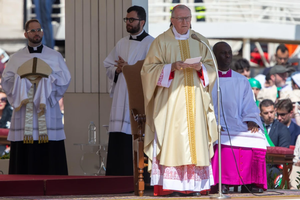Carlo Acutis and the Four Popes
As the Church prepares for a conclave to elect a new pope, tens of thousands of young pilgrims who traveled to Rome for the canonization remain in the Eternal City.

The unexpected death of Pope Francis on Easter Monday, April 21, postponed the much-anticipated canonization of Carlo Acutis, the Italian teenager who captivated a generation of young Catholics with his love of the Eucharist and passion for technology.
Now, as the Church prepares for a conclave to elect a new pope, tens of thousands of young pilgrims who traveled to Rome for the canonization remain in the Eternal City, holding vigil for the departed pope.
Acutis’ journey to sainthood has unfolded alongside the lives of the last three popes, each of whom has marked a different chapter in the teenager’s short life and legacy.
Carlo went on pilgrimage to see John Paul II, offered up his suffering from cancer for Benedict XVI, and was later beatified during the pontificate of Pope Francis. Now, it will be up to the next pope to canonize the Church’s first millennial saint.
A childhood inspired by John Paul II
Born in 1991 during the pontificate of John Paul II, Carlo Acutis grew up at a time when the Polish pontiff was inspiring millions with his travels and teaching. It was Carlo’s Polish nanny, herself devoted to the pope, who helped cultivate Carlo’s early faith.
In October 2000, the Acutis family traveled to Rome to attend a landmark moment of the Great Jubilee: Pope John Paul II’s act of entrustment of the new millennium to the Immaculate Heart of Mary. Standing in St. Peter’s Square, the then-9-year-old Carlo witnessed a crowd united in prayer, gathered beneath Bernini’s colonnade and in front of a statue of Our Lady of Fátima.
“The Church today, through the voice of the successor of Peter, in union with so many pastors assembled here from every corner of the world, seeks refuge in your motherly protection and trustingly begs your intercession as she faces the challenges which lie hidden in the future,” John Paul II prayed to Our Lady.
Offering his suffering for Benedict XVI
When white smoke emerged from the Sistine Chapel in April 2005, 13-year-old Carlo Acutis watched closely as Cardinal Joseph Ratzinger was elected Pope Benedict XVI. According to his mother, Carlo was “fascinated” by Benedict XVI.
The following year, Carlo was diagnosed with leukemia. Before he died of cancer in October 2006, he offered up his suffering for Benedict XVI saying: “I offer all the suffering I will have to endure to the Lord for the pope and for the Church, in order not to go through purgatory and to go straight to heaven.”
Beatification under Pope Francis
Pope Francis declared Carlo Acutis’ heroic virtue in 2018 and recognized the two miracles attributed to Carlo’s intercession that made possible his beatification and canonization.
Francis frequently cited Carlo as a model for youth in the digital age. In Christus Vivit, his apostolic exhortation to young people, Francis wrote that Carlo’s life stood as a witness against the temptation of “self-absorption, isolation, and empty pleasure” in the digital world.
“His witness indicates to today’s young people that true happiness is found by putting God in first place and serving him in our brothers and sisters, especially the least,” Pope Francis said the day after Carlo’s beatification in 2020.
Pope Francis had been scheduled to preside over Carlo’s canonization on April 27 during a jubilee event expected to draw 80,000 teenagers to Rome. Instead, that Mass will now be offered as one of the Novendiales — the nine days of mourning that follow the death of a pope — as part of a revised schedule for the Jubilee of Teenagers.
A saint for the next pope
Carlo Acutis’ canonization will now be one of the first major acts awaiting the next pope. The timing and location of the canonization Mass will be left to the discretion of Francis’ successor, who will likely recognize the moment as an opportunity to speak to the Church’s future and to its youth as the canonization of the Catholic Church’s first millennial saint.
- Keywords:
- blessed carlo acutis
















